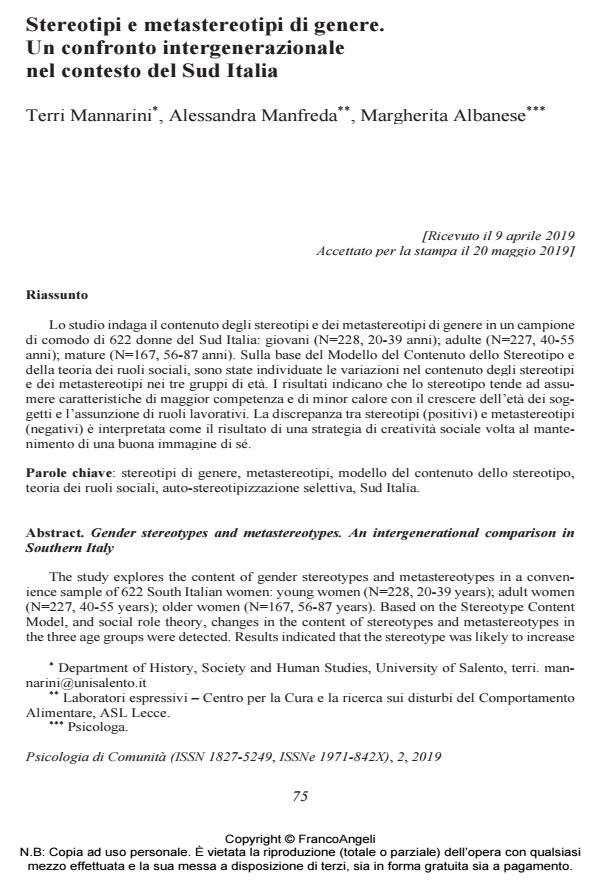Stereotipi e metastereotipi di genere. Un confronto intergenerazionale nel contesto del Sud Italia
Titolo Rivista PSICOLOGIA DI COMUNITA’
Autori/Curatori Terri Mannarini, Alessandra Manfreda, Margherita Albanese
Anno di pubblicazione 2020 Fascicolo 2019/2
Lingua Italiano Numero pagine 18 P. 75-92 Dimensione file 317 KB
DOI 10.3280/PSC2019-002006
Il DOI è il codice a barre della proprietà intellettuale: per saperne di più
clicca qui
Qui sotto puoi vedere in anteprima la prima pagina di questo articolo.
Se questo articolo ti interessa, lo puoi acquistare (e scaricare in formato pdf) seguendo le facili indicazioni per acquistare il download credit. Acquista Download Credits per scaricare questo Articolo in formato PDF

FrancoAngeli è membro della Publishers International Linking Association, Inc (PILA)associazione indipendente e non profit per facilitare (attraverso i servizi tecnologici implementati da CrossRef.org) l’accesso degli studiosi ai contenuti digitali nelle pubblicazioni professionali e scientifiche
Lo studio indaga il contenuto degli stereotipi e dei metastereotipi di genere in un campione di comodo di 622 donne del Sud Italia: giovani (N=228, 20-39 anni); adulte (N=227, 40-55 anni); mature (N=167, 56-87 anni). Sulla base del Modello del Contenuto dello Stereotipo e della teoria dei ruoli sociali, sono state individuate le variazioni nel contenuto degli stereotipi e dei metastereotipi nei tre gruppi di età. I risultati indicano che lo stereotipo tende ad assumere caratteristiche di maggior competenza e di minor calore con il crescere dell’età dei soggetti e l’assunzione di ruoli lavorativi. La discrepanza tra stereotipi (positivi) e metastereotipi (negati-vi) è interpretata come il risultato di una strategia di creatività sociale volta al mantenimento di una buona immagine di sé.
Parole chiave:Stereotipi di genere, metastereotipi, modello del contenuto dello stereotipo, teo-ria dei ruoli sociali, auto-stereotipizzazione selettiva, Sud Italia.
- Men are from Mars, women are from Venus: on lenders’ stereotypical views and the implications for a firm’s debt Mariasole Bannò, Giorgia Maria D’Allura, Graziano Coller, Celeste Varum, in Journal of Management and Governance /2023 pp.651
DOI: 10.1007/s10997-022-09641-w
Terri Mannarini, Alessandra Manfreda, Margherita Albanese, Stereotipi e metastereotipi di genere. Un confronto intergenerazionale nel contesto del Sud Italia in "PSICOLOGIA DI COMUNITA’" 2/2019, pp 75-92, DOI: 10.3280/PSC2019-002006